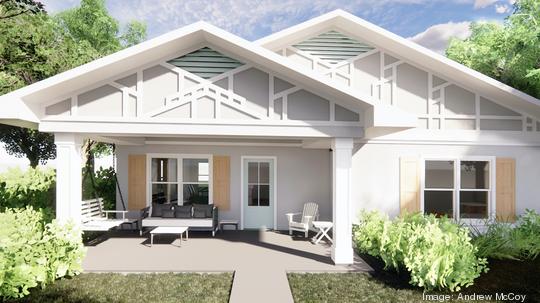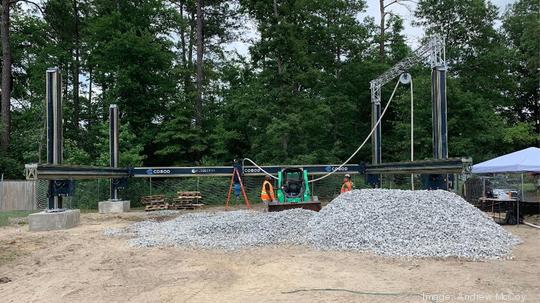
Lesterine Lee has lived in her home for 16 years, and she’s never seen anything quite like what’s happening next door.
For the first time ever in Virginia, builders are using 3D printing technology to assist in the construction of a house on Carnation Street in south Richmond, said Dr. Andrew McCoy, director of the Virginia Center of Housing Research at Virginia Tech.
“Exciting,” Lee told Inno from her front porch. “It’s interesting to watch.”
A 3D construction printer, developed by Denmark manufacturer COBOD and purchased for this project by 3D printing construction company Alquist, recently began building the exterior walls of what will be a 1,550-square-foot, three-bedroom house.
The BOD2 printer is a new edition and uses a unique printing method, McCoy said. The Virginia Center of Housing Research is a partner in the project. He described the device as a huge ink jet printer with a “Z,” or vertical, axis. The medium is concrete instead of ink, and its role is to construct the exterior wall of the house layer by layer.
"The concrete is extruded through a two-inch nozzle that lays one layer on top of another. Each layer is three-fourths of an inch high and builds the house through multiple passes,” McCoy said.
The printer uses a solid concrete mix with a high level of cement content. McCoy said the cement acts as a binder that attaches to previous layers.
All aspects of the print and design are built virtually in a Building Information Model long before going on-site, he said. This helps the 3D printer to understand, for example, where a space for a window should be.
”In the BIM, we can locate every part of the building precisely — outlets, plumbing, fixtures and so forth — so that the printer knows where to start and stop while printing," McCoy said.

This innovative project became a reality thanks to a collaboration with partners that include Virginia Housing Development Authority, Virginia Center for Housing Research at Virginia Tech and Alquist. The work on Carnation Street is poised to be the beginning of anticipated growth in the emerging 3D printing construction industry as consumers seek more affordable, sustainable living spaces.
The Virginia Housing Development Authority provided a $500,000 grant to fund the use of the 3D printer in the Carnation Street home’s construction.
“The global pandemic has escalated a severe shortage of affordable housing options in Virginia,” Chris Thompson, director of strategic house with the VHDA, said. “Housing is a fundamental building block, interlinked with so many other sectors. This is why we should all care (about finding a solution).”
According to the Partnership for Housing Affordability, approximately 35% of all households in the region are cost burdened. Thompson said 3D home printing offers enormous potential to help lower the cost of a home, especially in light of recent pandemic challenges which saw rising costs in labor and building materials such as lumber.
McCoy said 3D printing technology could provide a viable solution.
”3D concrete printing for this demonstration house should take around 15 hours total for the exterior walls,” he said. “That should eliminate approximately three weeks of work with multiple trades. It means that a builder can get the house 'dried in' faster, which means fewer delays to weather and faster time to market.”
Additionally, McCoy said long-term, a 3D-printed home is much more sustainable and affordable. He estimates the Carnation Street home will have an electric bill between $15 and $20 per month.
The total construction cost for a 1,550-square-foot home using 3D print technology is between $180,000 and $190,000 and can be sold for about $220,000, he said.
Thompson said what’s happening at the prototype home on Carnation Street is just the beginning in what he hopes could change the way homes are constructed throughout the Commonwealth.
“We intend to take our learnings from here in Richmond to other parts of the Commonwealth,” he said. “We are also exploring this partnership to evaluate options for multi-story and multifamily housing.”